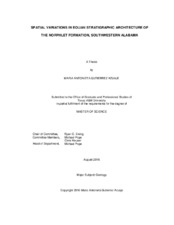Spatial Variations in Eolian Stratigraphic Architecture of the Norphlet Formation, Southwestern Alabama
Abstract
In modern eolian dune fields, dune-field patterns arise from the autogenic behavior of dunes and the external environmental conditions within these interactions operate. When autogenic behaviors alone are considered, a generic pattern emerges with little variability in the pattern but much spatial variability arises as a dune-field pattern emerges within a set of boundary conditions. One way in which this variability is expressed in modern dune fields is by an increase in crest line spacing and decrease of defect density away from a sand source area. To determine if this dune pattern behavior is apparent in the eolian rock record, we studied the Upper Jurassic Norphlet Formation with the aim of inferring the stratigraphic configuration of a limited area, based on the detailed facies analysis and their vertical and lateral variations from three cores recovered at increasing distance from inferred upland source areas. Detailed facies interpretation was performed and eolian set and grainflow thickness were measured in three cores. Results indicate that spatial and temporal depositional changes occurred in the system during Norphlet Formation deposition, evidenced by lateral facies variability from fluvial-eolian to mainly eolian deposition in the erg center. Facies identified include interdune, wadi, eolian dune, sandsheet and marine facies. Spatially the dune field transitioned from a fluvially dominated margin with small eolian sets to an eolian dominated dune-field center with the thickest overall sets. An increase in set thickness and decrease in the total number of first order bounding surfaces moving away from the sediment source were identified, with set thickness ranging between 1 to 6 m in the erg center. Preserved grainflow thickness shows a positive correlation with distance from the sediment paleosource, with a significant population between 0.5 and 1.6 cm thick for the middle and distal locations.
Temporal changes transitioned upward from wet interdune strata to wadi and dry dune facies, to an interval of sandsheets that grades to marine deposits. Foreset strata orientation from dipmeters indicates scatter bedding directions for the updip location but a narrower distribution in Hatters Pond (SW) and Mobile Bay (SE-E), suggesting these as the prevailing wind directions in those areas. The succession implies a relative sea level rise at the end of the Norphlet deposition. Interpreted climatic conditions suggest a wetter fluvio-eolian system prevailed in the updip location that changed to a dryer dune dominated area in the dune field center. The transition to the uppermost Norphlet section characterized by sandsheets and marine siltstones, indicates a combination of decrease in sediment availability, increase in sea level, and increase in water table level, leading to cessation of eolian deposition.
Citation
Gutierrez Azuaje, Maria Antonieta (2016). Spatial Variations in Eolian Stratigraphic Architecture of the Norphlet Formation, Southwestern Alabama. Master's thesis, Texas A & M University. Available electronically from https : / /hdl .handle .net /1969 .1 /158062.


